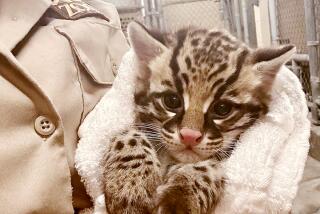Olinguitos’ back-story should make zookeepers blush
- Share via
Probably the only thing more exciting than discovering a new planet in our universe is discovering a new animal on our planet. The mere thought raises expectations for its exoticness. Maybe it will look like a flying cat, or a mini-giraffe that sits on your lap.
In fact, the animal being hailed as the newest discovery in the mammalian animal kingdom looks disappointingly familiar. (“Wait, haven’t I seen that before?”) Kind of like a chubby mongoose, with a lot of fur of a brownish rust color peppered with black. Teddy bear round ears soften the face. Insanely long nails, no doubt a necessity for living in Andean tree tops, add to its edginess.
Even its name is derivative: Olinguito, the first mammal in the order carnivora to be discovered in the Western Hemisphere in 35 years, is an affectionate term in Spanish for “little olingo” — a member of the raccoon family.
What’s really exciting about this discovery is not the olinguito’s looks but the fact that it was so subtly different from its relative, the larger, more brownish olingo, that animal experts assumed they were the same. Zookeepers had even mistakenly put olinguitos in the same exhibit with olingos. In at least one zoo, the olinguito puzzled zookeepers by refusing to mingle — or do more — with the olingos. The olinguito knew what the people didn’t, of course. The others just weren’t his type.
It took years of detective work by Kristofer Helgen, curator of mammals at the Smithsonian National Museum of Natural History and the lead author of a paper describing the olinguito published Thursday in the journal ZooKeys, to prove that not all the pelts of animals in museum archives classified as olingos were really olingos, and then to track the mysteriously different animal to the fog-shrouded tree tops in the Andes. Weighing in at an average 2 pounds, olinguitos are the smallest members of the raccoon family, sleep during the day, tree hop at night and, despite the carnivora taxonomic order, do not eat meat, feasting instead on figs, insects and plant nectar.
What’s so remarkable about this story is the discovery of something new in what we thought was known. It speaks volumes about how important archival study is. This researcher had set out just to count the number of subspecies of the olingo, not to find a new species altogether. And it also offers a reason why zoos — sometimes criticized for keeping animals in bored captivity — should do more research into the behaviors and quirks of the animals in their collections. Imagine if the perplexed keepers of the standoffish olinguito had invited researchers in to observe closely.
Certainly, the mere discovery of this new layer of complexity in the animal world makes it even more tawdry that a Chinese zoo this week was outed for swapping a large Tibetan mastiff for a lion in its exhibit. It’s unclear if the zoo hoped people would really believe the dog was an African lion (despite the “African lion” title by the exhibit.) It’s just lame on any level — not to mention an insult to lions, dogs and zoo visitors.
ALSO:
Feinstein and Durbin: How to close Gitmo
More to Read
A cure for the common opinion
Get thought-provoking perspectives with our weekly newsletter.
You may occasionally receive promotional content from the Los Angeles Times.









